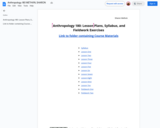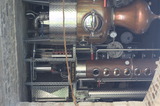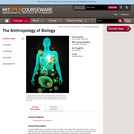
https://docs.google.com/presentation/d/10csVedOuKMWjyZkiujCwJEAGhWuAqaCqaH7kUETXHdk/edit?usp=sharing
- Subject:
- Anthropology
- Material Type:
- Homework/Assignment
- Author:
- Yakov Nakash
- Date Added:
- 12/17/2022

https://docs.google.com/presentation/d/10csVedOuKMWjyZkiujCwJEAGhWuAqaCqaH7kUETXHdk/edit?usp=sharing

This online article explains the meticulous care and tracking that goes into storing the 530,000 items in the museum's anthropology collection. Along with discussing the inherent differences between the items in each of the collection's three subdivisions (archaeology, ethnology, and biological anthropology), the article covers the nature of collections, preserving anthropology collections and computerizing collections management

This online article introduces students to the Objects Conservation Laboratory run by the museum's Anthropology Division. It discusses the main activities of the lab's conservators what that process involves.

This course introduces students to some of the major social theories and debates that inspire and inform anthropological analysis. Over the course of the semester, we will investigate a range of theoretical propositions concerning such topics as agency, structure, subjectivity, history, social change, power, culture, and the politics of representation. Ultimately, all theories can be read as statements about human beings and the worlds they create and inhabit. We will approach each theoretical perspective or proposition on three levels: (1) in terms of its analytical or explanatory power for understanding human behavior and the social world; (2) in the context of the social and historical circumstances in which they were produced; and (3) as contributions to ongoing dialogues and debate.

The purpose of this course is the study of human communication across the life span from a temporal-spatial approach. Specifically, the course examines human communication from an evolutionary and adaptive perspective and explores the fundamental question, in what way does culture shape communication and communication shape culture?
Contains syllabus, ten lessons, and two fieldwork exercises for a ten-week course.

Assignment and discussion prompts for 100-level anthropology courses. Scoring criteria are included.

This is a collection of mini lectures created by anthropologists and those in conversation with anthropology as supplimental material to assist college and university instructors who were made to shift their courses online because of COVID19.For more information, see here.To contribute, please create an OER author account and send your name and OER registered email to AnthropologyTeaching@gmail.com.

This class examines how anthropology and speculative fiction (SF) each explore ideas about culture and society, technology, morality, and life in “other” worlds. We investigate this convergence of interest through analysis of SF in print, film, and other media. Concepts include traditional and contemporary anthropological topics, including first contact; gift exchange; gender, marriage, and kinship; law, morality, and cultural relativism; religion; race and embodiment; politics, violence, and war; medicine, healing, and consciousness; technology and environment. Thematic questions addressed in the class include: what is an alien? What is “the human”? Could SF be possible without anthropology?

ANTH 150 World Archaeology
Introduction to archaeology and cultural change from the earliest times to the advent of state-level societies.
Course Description:
• When did we become fully modern humans?
• When (and why) did we stop being hunter-gatherers?
• When did inequality emerge?
• Why did some people decide to start living in cities?
• What led to the development of complex state-level
societies?
These are important questions about what it means to
be human that archaeologists address. In this course,
we’ll consider these topics while providing an
introduction to archaeology and the study of world
prehistory. The course provides an overview of human
prehistory from modern humans up to the
development of literate civilizations. The approach will
be problem oriented and comparative. We will
consider ancient cultures from around the world in
order to foster an appreciation for human cultural
diversity. Explaining why cultural developments
occurred is often hotly debated among archaeologists,
and different perspectives will be explored critically
throughout this course.

The following pages describe anthropology's relationship with colonialism. The reading emphasizes why colonial history is relevant to students' lives and emphasizes practical ways to practice cultural relativism.

The following pages describe anthropology's relationship with colonialism. The reading emphasizes why colonial history is relevant to students' lives and emphasizes practical ways to practice cultural relativism.

The following pages describe anthropology's relationship with colonialism. The reading emphasizes why colonial history is relevant to students' lives and emphasizes practical ways to practice cultural relativism.

This course applies the tools of anthropology to examine biology in the age of genomics, biotechnological enterprise, biodiversity conservation, pharmaceutical bioprospecting, and synthetic biology. It examines such social concerns such as bioterrorism, genetic modification, and cloning. It offers an anthropological inquiry into how the substances and explanations of biology—ecological, organismic, cellular, molecular, genetic, informatic—are changing. It examines such artifacts as cell lines, biodiversity databases, and artificial life models, and using primary sources in biology, social studies of the life sciences, and literary and cinematic materials, and asks how we might answer Erwin Schrodinger’s 1944 question, “What Is Life?” today.

This course applies the tools of anthropology to examine biology in the age of genomics, biotechnological enterprise, biodiversity conservation, pharmaceutical bioprospecting, and synthetic biology. It examines such social concerns such as bioterrorism, genetic modification, and cloning. It offers an anthropological inquiry into how the substances and explanations of biology — ecological, organismic, cellular, molecular, genetic, informatic — are changing. The course also examines such artifacts as cell lines, biodiversity databases, and artificial life models, and using primary sources in biology, social studies of the life sciences, and literary and cinematic materials, asks how we might answer Erwin Schrödinger’s 1944 question, “What Is Life?”, today.

This course applies the tools of anthropology to examine biology in the age of genomics, biotechnological enterprise, biodiversity conservation, pharmaceutical bioprospecting, and synthetic biology. It examines such social concerns such as bioterrorism, genetic modification, and cloning. It offers an anthropological inquiry into how the substances and explanations of biology—ecological, organismic, cellular, molecular, genetic, informatic—are changing. It examines such artifacts as cell lines, biodiversity databases, and artificial life models, and using primary sources in biology, social studies of the life sciences, and literary and cinematic materials, and asks how we might answer Erwin Schrodinger’s 1944 question, “What Is Life?” today.

This course explores a range of contemporary scholarship oriented to the study of ‘cybercultures,’ with a focus on research inspired by ethnographic and more broadly anthropological perspectives. Taking anthropology as a resource for cultural critique, the course will be organized through a set of readings chosen to illustrate central topics concerning the cultural and material practices that comprise digital technologies. We’ll examine social histories of automata and automation; the trope of the ‘cyber’ and its origins in the emergence of cybernetics during the last century; cybergeographies and politics; robots, agents and humanlike machines; bioinformatics and artificial life; online sociality and the cyborg imaginary; ubiquitous and mobile computing; ethnographies of research and development; and geeks, gamers and hacktivists. We’ll close by considering the implications for all of these topics of emerging reconceptualizations of sociomaterial relations, informed by feminist science and technology studies.

This course introduces the ethnographic study of politics, i.e., what anthropologists understand to be “political” in various social and economic systems, from small-scale societies to liberal democratic states. It examines politics across three contemporary contexts: electoral politics, public spheres, bureaucracies and humanitarian governance. Students consider and analyze how questions of authority, coercion, and violence have been theorized to relate to the political, and how some aspects of social life are regimented in explicitly non-political ways.

This course examines the birth and international expansion of an American industry of political marketing. It focuses attention on the cultural processes, sociopolitical contexts and moral utopias that shape the practice of political marketing in the U.S. and in different countries. By looking at the debates and expert practices at the core of the business of politics, the course explores how the “universal” concept of democracy is interpreted and reworked through space and time, while examining how different cultural groups experimenting with political marketing understand the role of citizens in a democracy.

This class examines the ways humans experience the realm of sound and how perceptions and technologies of sound emerge from cultural, economic, and historical worlds. In addition to learning about how environmental, linguistic, and musical sounds are construed cross-culturally, students learn about the rise of telephony, architectural acoustics, and sound recording, as well as about the globalized travel of these technologies. Questions of ownership, property, authorship, and copyright in the age of digital file sharing are also addressed. A major concern will be with how the sound/noise boundary has been imagined, created, and modeled across diverse sociocultural and scientific contexts. Auditory examples — sound art, environmental recordings, music — will be provided and invited throughout the term.

This course examines the ways humans experience sound and how perceptions and technologies of sound emerge from cultural, economic, and historical worlds. It considers how the sound/noise/music boundaries have been imagined, created, and modeled across sociocultural and historical contexts. Students will learn how environmental, linguistic, and musical sounds are construed cross-culturally as well as the rise of telephony, architectural acoustics, sound recording, multi-channel and spatial mix performance, and the globalized travel of these technologies. Questions of sound ownership, property, authorship, remix, and copyright in the digital age are also addressed.